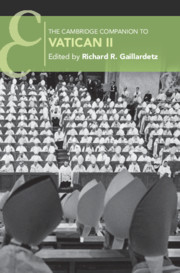Book contents
- The Cambridge Companion to Vatican II
- Cambridge Companions to Religion
- The Cambridge Companion to Vatican II
- Copyright page
- Dedication
- Contents
- Abbreviations of Conciliar Documents
- Contributors
- Preface
- Part I Vatican II in Context
- Part II Conciliar Themes and Reception
- 7 The Pilgrim Church
- 8 The Church in Mission
- 9 Revelation
- 10 Liturgy
- 11 The Word and Spirit Co-instituting the Church
- 12 The Christian Faithful
- 13 Leadership and Governance in the Church
- 14 Ministry in the Church
- 15 Professed Religious Life
- 16 Ecumenism
- 17 The Church and Other Religions
- 18 The Renewal of Moral Theology
- Appendix: Sources for the Study of Vatican II
- Index of Names
- Index of Subjects
- Index of Conciliar References
- Series page
- References
7 - The Pilgrim Church
An Ongoing Journey of Ecclesial Renewal and Reform
from Part II - Conciliar Themes and Reception
Published online by Cambridge University Press: 14 May 2020
- The Cambridge Companion to Vatican II
- Cambridge Companions to Religion
- The Cambridge Companion to Vatican II
- Copyright page
- Dedication
- Contents
- Abbreviations of Conciliar Documents
- Contributors
- Preface
- Part I Vatican II in Context
- Part II Conciliar Themes and Reception
- 7 The Pilgrim Church
- 8 The Church in Mission
- 9 Revelation
- 10 Liturgy
- 11 The Word and Spirit Co-instituting the Church
- 12 The Christian Faithful
- 13 Leadership and Governance in the Church
- 14 Ministry in the Church
- 15 Professed Religious Life
- 16 Ecumenism
- 17 The Church and Other Religions
- 18 The Renewal of Moral Theology
- Appendix: Sources for the Study of Vatican II
- Index of Names
- Index of Subjects
- Index of Conciliar References
- Series page
- References
Summary
The council recovered a more eschatological understanding of the church as a pilgrim people. This emphasis on the “pilgrim” character of the church would prove among the major factors in bringing about the transformation of the self-understanding of the church, thereby providing a theological opening for the council’s program of aggiornamento. Combined with the emergence of an equally dynamic and open-ended pneumatological emphasis in conciliar ecclesiological thinking, this “eschatological turn” helped create conditions for the possibility of major ecclesial renewal and reform. This chapter will consider the emergence and development of such ecclesiological elements in the council’s vision, considering the key particular texts that specifically gave expression to this open-ended sense of the church’s life, mission, and relationship to the wider world.
Keywords
- Type
- Chapter
- Information
- The Cambridge Companion to Vatican II , pp. 115 - 135Publisher: Cambridge University PressPrint publication year: 2020



